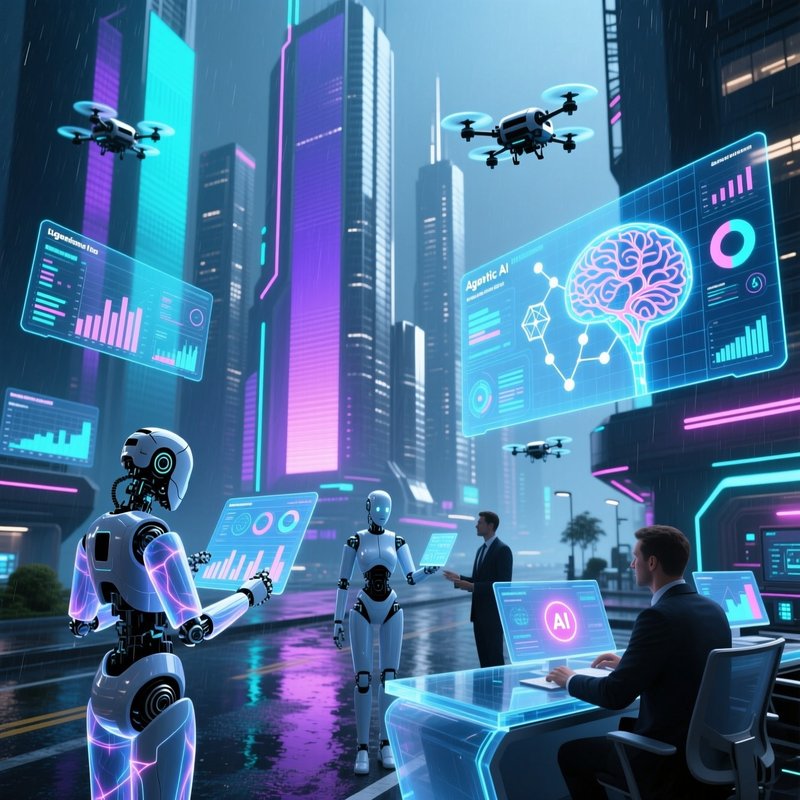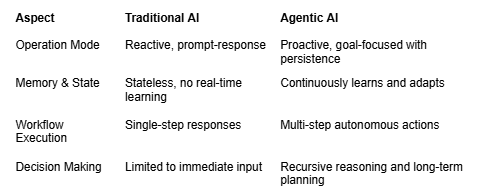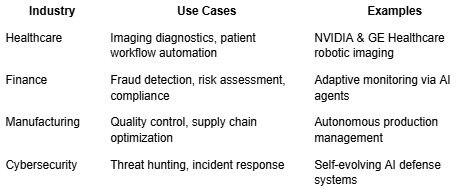Agentic AI: The Future of Autonomous Intelligence Transforming Industries by 2025-26
Artificial Intelligence is evolving faster than ever, moving beyond tools that simply answer questions to systems that think, decide, and learn on their own. This exciting leap is thanks to Agentic AI purpose-driven AI agents that plan, act, and adapt proactively. They’re changing the way businesses work and collaborate with AI in fundamental ways. In this article, we dive into what agentic AI is all about, how it works, the latest trends, real-life examples, challenges, and what organizations can do to get ready and succeed in this new AI-powered world.

What is Agentic AI? Understanding the Leap to Autonomous Intelligence
Traditional AI models—like the large language models behind ChatGPT work reactively. You send a prompt, they respond. That’s it. There’s no ongoing context or memory that lasts beyond the moment.
Agentic AI works differently. It operates independently and continuously, driving toward clear goals over time.
Here’s a quick comparison:

In other words, agentic AI doesn’t just spit out answers—it thinks, plans, acts, watches results, and adjusts its course all on its own until it reaches its goals.
The Core Mechanism: The Reasoning-Acting Loop
At the center of agentic AI is what we call the reasoning-acting loop. Imagine it as an ongoing cycle where the AI:
- Perceives: Gathers information from its environment or data sources.
- Plans: Figures out the best steps to reach its goals based on what it knows.
- Acts: Executes tasks or makes decisions.
- Monitors: Watches the outcomes and any changes around it.
- Adjusts: Tweaks its plans and actions based on feedback and new info.
This cycle transforms agentic AI from a simple tool into a self-driven operator that handles complex, changing workflows all on its own.
From AI Tools to Autonomous Operational Models
Agentic AI is more than just a smarter tool it’s a whole new way of working:
- Old way: AI helps humans perform tasks but needs manual setup and supervision.
- New way: AI runs the workflows itself, coordinating multi-step processes and making decisions in real time, no babysitting required.
This shift means workflows become faster, more flexible, and can scale with less human oversight freeing people to focus on higher-impact work.
Specialization: The Rise of Vertical AI Agents
While general AI models grab headlines, we’re seeing a surge in specialized AI agents fine-tuned for particular industries. These focused agents deliver better results and follow industry rules more closely. A few examples:
- Healthcare: AI that analyzes medical images or manages patient follow-ups while respecting privacy laws.
- Finance: Agents spotting fraud, assessing risk dynamically, and keeping up with regulations.
- Manufacturing: Automating quality checks and managing supply chains seamlessly.
- Cybersecurity: Hunting threats and adapting defenses all on their own.
By zeroing in on specific fields, these AI agents become trusted allies that get the job done with precision.
Tight Integration with IoT and Physical Systems
Agentic AI isn’t just living in the cloud it’s blending with physical devices and infrastructure through the Internet of Things (IoT), allowing for:
- Smart homes, offices, and even cities that manage themselves autonomously.
- Real-time robotic diagnostics in healthcare (think NVIDIA and GE Healthcare’s robotic imaging solutions).
- Industrial robots and environmental sensors running intelligent, automated processes.
This tight connection between AI and the physical world paves the way for truly smart environments that take care of themselves.
The Future of Data Pipelines: Autonomous and Self-Healing
Data drives AI, and as agentic AI grows, data pipelines are evolving too. Soon, they’ll be:
- Self-healing: Spotting and fixing issues without human intervention.
- Reinforcement learning-powered: Getting better over time by learning from what works.
- Modular and multi-agent: Teams of AI agents working together to keep data flowing smoothly.
This means less time spent firefighting data problems and more reliable information powering AI decisions.
Multi-Agent Systems and Orchestration
Big business workflows can be complicated, but agentic AI is up to the task by forming multi-agent ecosystems where specialized AI agents:
- Break down tasks and work together smartly.
- Communicate and resolve conflicts in real time.
- Manage large-scale workflows seamlessly across departments.
Platforms like OpenAI Swarm, LangGraph, and Microsoft Autogen are already making it easier for these agent teams to collaborate toward shared goals.
Self-Evolving AI Architectures: The Next Frontier
The next wave of agentic AI systems are learning to rewrite their own code and strategies on the fly, especially in areas like:
- Cybersecurity: Reacting instantly to new, unknown threats.
- Optimization: Constantly sharpening their problem-solving skills without human help.
This self-evolution keeps AI agents resilient and creative, even as challenges change.
Open Source Gains Momentum Amid Industry Dynamics
Agentic AI is becoming more accessible thanks to a growing open source movement:
- Models like Anthropic and Mistral are gaining popularity.
- Commercial providers are lowering costs and expanding access to keep pace.
This mix of open and proprietary tech sparks innovation, reduces dependency on single vendors, and helps startups and enterprises jump on board faster.
Human Workforce and Agentic AI: A New Collaborative Paradigm
Agentic AI won’t replace humans—it will change how we work together:
- Analysts and domain experts will design and fine-tune AI-driven workflows.
- Engineers will build automation and maintain AI infrastructure.
- Humans remain key in overseeing AI, guiding ethics, and blending human judgment with AI capabilities.
This partnership combines the best of both worlds, balancing innovation with care and oversight.
Emerging Business & Pricing Models
As AI agents become “digital coworkers,” business models are evolving:
- Traditional software licenses are giving way to pay-as-you-use or AI salary models.
- For instance, Hippocratic AI offers nursing agents at around $10 an hour—much less than the median $43 per hour for human nurses.
These fresh approaches make scaling AI workforces more affordable and flexible.
Governance, Ethics, and Responsible Deployment
With great power comes great responsibility. Deploying agentic AI widely requires:
- Transparency and explainability to build trust.
- Bias mitigation and clear audit trails to keep things fair and compliant.
- Careful oversight, especially in sensitive areas like healthcare and finance.
Embedding these practices helps capture AI’s benefits without compromising ethics or safety.
Energy Efficiency and Hardware Innovation
Agentic AI’s power demands have sparked advances in:
- AI-optimized hardware built for efficiency.
- Edge computing to process data closer to where it’s created, cutting latency.
- Hybrid models that balance the cloud with local processing.
These innovations help make AI deployment more sustainable and scalable.
Industry Adoption & Real-World Use Cases
Here’s where agentic AI is making a real impact:

These cases show how agentic AI is already transforming critical industries.
Market Forecast & Strategic Imperatives
- Gartner predicts AI system spending will hit $300 billion by 2026, growing at about 26.5% annually.
- By 2028, one in three enterprise software products will have agentic AI baked in up from less than 1% in 2024.
Companies that jump in early by building strong data foundations, guiding AI governance, and embracing modular designs will be ahead of the curve.
How to Prepare Your Organization for Agentic AI
- Build solid data foundations that support autonomous, self-healing AI agents.
- Focus on AI governance by crafting policies around transparency, fairness, and compliance.
- Adopt modular AI architectures to enable flexible, multi-agent workflow automation.
- Train your workforce to work alongside AI agents in hybrid roles.
- Pilot industry-specific AI agents to address targeted needs effectively.
- Invest in infrastructure that uses energy-efficient hardware and edge computing for smooth AI operation.
Conclusion: The Dawn of Autonomous Intelligence
Agentic AI marks an exciting shift to proactive, self-directed artificial intelligence that will reshape industries, change how humans and machines collaborate, and transform how businesses operate from the ground up. Organizations ready to invest wisely in data, governance, and their people won’t just keep up they’ll thrive in this fast-moving AI future.
Staying curious, adaptable, and ethical will be key as agentic AI moves into the mainstream by 2025-2026 and beyond.
Further Reading & Resources
- Gartner Report on AI Spending and Trends (2025)
- OpenAI Swarm: Multi-Agent AI Framework
- Anthropic AI Open Source Models
- Hippocratic AI: Transforming Healthcare Staffing with Agentic Nurses
Step into the future of AI-powered autonomy—embrace agentic AI today. with decodermind

 Hamid Salman
Hamid Salman